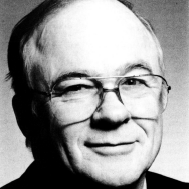The recipient of this year’s award is Wayne Davis. The Canadian Human-Computer Communications Society (CHCCS) wishes to recognize and acknowledge his unswerving commitment and many contributions to the Society. We also recognize that his many activities have done much to maintain a hospitable climate in Canada for research and development in computer graphics and human-computer interaction.
Wayne was born in Fort Macleod, Alberta in 1931 and received his elementary schooling there. He received a B.S.E. degree in Engineering (Mathematics option) at George Washington University in 1961. Shortly afterwards he went to Ottawa to continue his studies at the University of Ottawa, receiving his M.Sc. and Ph.D. degrees in Electrical Engineering in 1963 and 1967, respectively. Wayne continued his studies while he was a Research Scientist with the Communications Research Centre and its predecessor, the Defence Research Telecommunication Establishment (Ottawa). Since 1969 Wayne has been on the faculty of the University of Alberta and has been a full Professor since 1977. Wayne took an early retirement from the formal side of the University in 1991, but has remained as the first Professor Emeritus in the Department of Computing Science. He was a founding member and later Acting Director of the Alberta Centre for Machine Intelligence and Robotics (ACMIR).
Wayne has wide ranging interests that span computer graphics, image processing and other aspects of computing. His specific research interests have ranged from geographical information systems to image processing and remote sensing. Wayne supervised one of the first Ph.D. students in the Department of Computing Science at the University of Alberta. Subsequently, Wayne supervised many Ph.D. and M.Sc. students, both in image processing and in graphics. His research, and that of his students, has resulted in about one hundred publications in professional journals, conference proceedings and technical reports.
In the 1980’s, Wayne was one of the main participants in the cooperative program with the Department of Computer and Information Science of the Harbin Shipbuilding Engineering Institute, Harbin, People’s Republic of China. He has made several visits to Harbin, lecturing there and in other places in the People’s Republic of China. Wayne has maintained links with university life in China; since 1985 he has been an Honorary Professor in the Department of Computer Science and Information Science at Harbin Shipbuilding Engineering Institute.
Wayne has been the guiding light and untiring leader of the CHCCS since it evolved from its humble beginnings. Through his parallel activities in the Canadian Image Processing and Pattern Recognition Society (CIPPRS) and in the Canadian Society for Computational Studies of Intelligence (CSCSI) he was responsible for bringing the respective conferences under one roof. A first tentative step to such conference was a graphics stream in the CSCSI Conference, organized by Wayne and held in Victoria in 1980 (a CMCCS off-year). After much persuasion by Wayne, either or both of the other two societies joined with CMCCS, and now CHCCS, to hold conferences in succeeding years.
Wayne’s interest in, and allegiance to, Western Canada has always been evident in his efforts to make CHCCS national in scope. While the early conferences were held in Ottawa with an occasional foray into other parts of eastern Canada, Wayne has been instrumental in bringing the conferences to Victoria, Vancouver, Edmonton and Calgary. In each case Wayne used his powers of persuasion to ensure that there was a strong conference organization. Consequently these conferences were highly successful. By making the Society such an ongoing success he has contributed inestimably towards the maintenance of a climate for exchanging research ideas and for providing researchers and especially students with a place to publish and to interact with researchers at other academic institutions.
Through this award, members of the Society wish to acknowledge Wayne’s many contributions to the overall development of computer graphics and human-computer interaction research in Canada.





